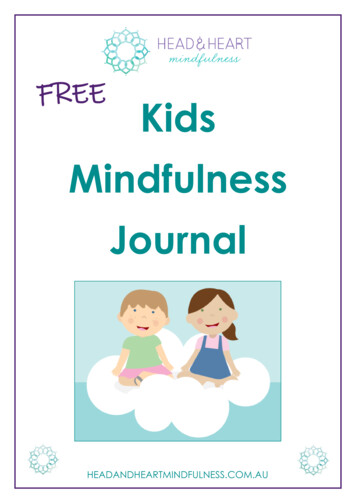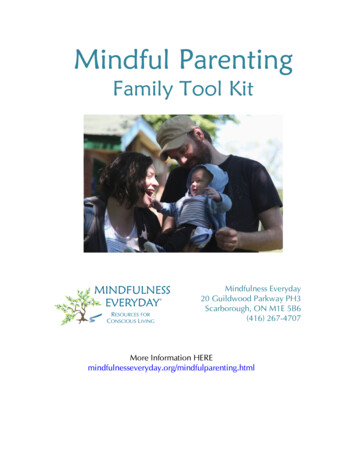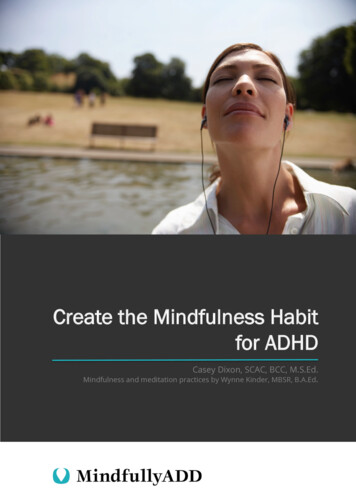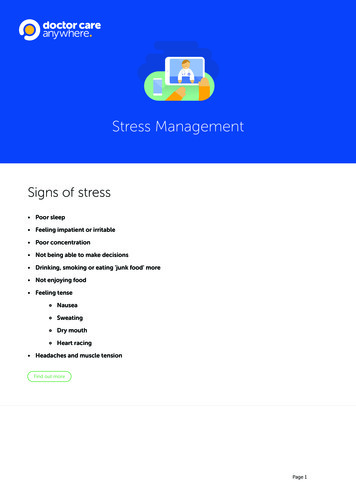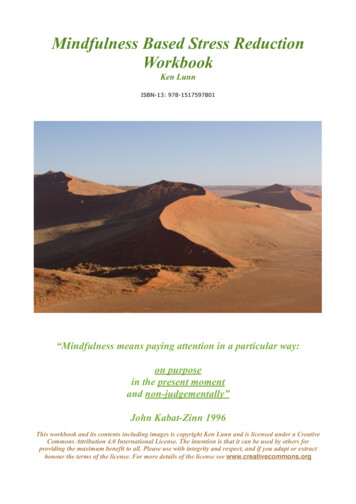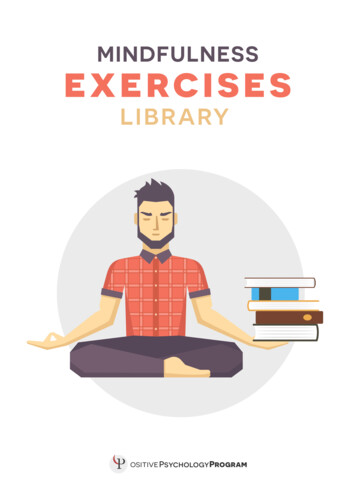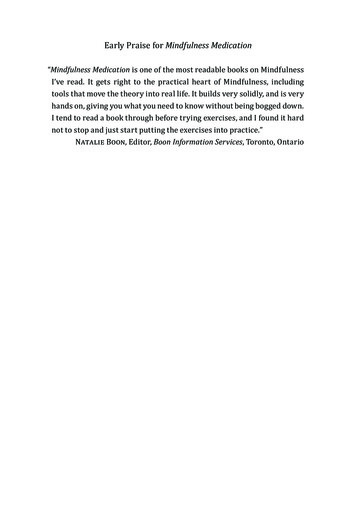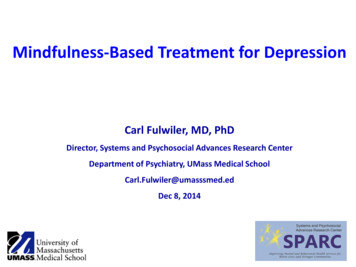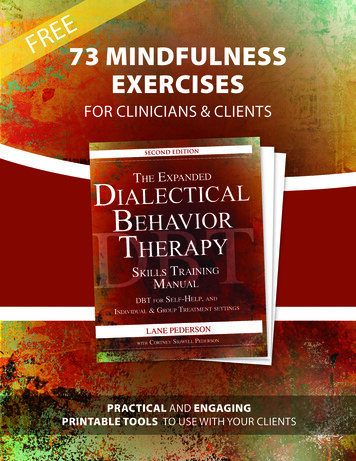
Transcription
University Counseling CenterWhat is Mindfulness?Mindfulness Training atMindfulness Meditation Trainingat SBUBeginning MindfulnessResourcesRelated LinksThe University Counseling Center understandsthe value of living and working in a caring andmindful community and is dedicated toenhancing MINDFUL AWARENESS on the SBUcampus. In order to do this, we offer a number ofdifferent programs to teach and developmindfulness to students, staff and faculty. Ourwebsite hopes to answer initial questions aboutmindfulness and mindfulness meditation,highlight the various trainings available inmindfulness and provide resources for you tofurther your inquiry into what mindfulnessmeditation has to offer.
University Counseling Center.WHAT IS MINDFULNESS?What is Mindfulness?Mindfulness Training atBeginning MindfulnessResourcesRelated LinksJohn Lennon captured the essence of non-mindful livingwhen he said, “Life is what happens to you while you’rebusy making other plans” (Beautiful Boy). It is so easy,and so natural, to live on “autopilot”, in your head,thinking about the past or planning for the future, allthe while missing the aliveness of the present moment.Whole lifetimes can go by this way, and they often do.This kind of automatic living reflects a “dis-connect”between mind and body and contributes to over-thinkingand intensified stress.Mindfulness has to do with particular dimensions ofattention and attitude that facilitate conscious living.It means paying attention to the present moment in aparticular way: on purpose and nonjudgmentally. This kindof attention helps us to be aware of what we arethinking, feeling and doing in the moment. It helps us tobe in our life, rather than in our “head”, and nurturesgreater awareness, clarity, and acceptance of presentmoment reality.DIMENSIONS OF MINDFULNESSON PURPOSE: Mindfulness has to do with paying attentionon purpose. Are you able to direct your attention withintention? Can you hold your attention on these words, oron any other chosen activity, in a conscious way?PRESENT time sense: being right here, right now. As youread these lines, is your attention here, right here onthis word, or are your thoughts drifting off to someother place and time?Are your awake to this trating some mindfulness.ACCEPTANCE: allowing an experience to be, as it is,without evaluating it as good or bad or wishing it couldbe different. This includes noticing a feeling andallowing it to be there, just as it is.Thisnonjudgmental quality proves to be difficult for most ofus, as we have well-developed faculties for analysis,criticism and judgment. What would it be like to let goof judgment for a while and simply observe?Mindfulness helps us develop conscious awareness ofourselves in the present moment so that we can respond tosituations with choice, rather than react automatically.CAN I DEVELOP MINDFULNESS?YES!Mindfulness is a universal quality that can becultivated and anyone, with the intention to do so, canlearn to practice and develop mindfulness. Mindfulness isnot the same as intelligence, although it certainly isintelligent to be mindful!Mindfulness involves specificattentional and attitudinal skills can be nurtured anddeveloped, and that may, in turn, contribute to increasedintelligence.The concept of mindfulness is simple,although its development requires intention and practice.WHAT ARE THE BENEFITS OF MINDFULNESS MEDITATION?Mindfulness Meditation is a way to practice and developmindfulness.It is, in a sense, the laboratory classfor the development of mindfulness.There has been an explosion of empirical research on thebenefits of mindfulness practice. In brief, thefollowing findings have been documented.PHYSICAL BENEFITS:Stress hardiness, immune system boosterDecrease in blood pressureDecrease in experience of chronic painPsoriasis alleviationPSYCHOLOGICAL AND EMOTIONAL ty for attention, concentrationdepressionanxietyregulationFor more complete references on the benefits ofmindfulness meditation, go to “Resources” and “Research”.
University Counseling CenterMindfulness Training at the UCCWhat is Mindfulness?Mindfulness Training atThe UCC offers several different kinds of training in Mindfulness Meditation (MM),free of charge, to undergraduate and graduate students. When possible, we mayprovide training for staff and faculty.Beginning MindfulnessResourcesRelated LinksFor Undergraduate & Graduate STUDENTS:8-Week Beginning Mindfulness Meditation Groupsfor Academic Success & Well BeingOffered at the beginning of Fall & Spring semesters, these groups provide a logical, stepby-step sequence of instruction and practice. We provide handouts & CD’s to facilitatelearning the skill of mindfulness & to develop a home practice. Groups are small & meetFor more information about this service: Brochures (listing group times) & registration formscome out early each semester and can be obtained from the UCC or by calling 632-6720.Please be sure to register early, as groups fill quickly.For STUDENTS who have some experience with MeditationContinuation Meditation GroupsFor those students who have had some experience with MM, we offer 8 week ongoing groups thatprovide continued training in the philosophy and practice of meditation. Readings, instructions andpractice are provided. Call 632-6720 for additional information about these groups.ForHSCSTUDENTS.A variety of different mindfulnessgroups are offered at the HSC’s satellitecounseling service. Call 444-7760 foradditional informationOUTREACH PROGRAMSAs part of its commitment to developing a mindful community oncampus, groups, the UCC extends its trainings to variousstudent and faculty groups, upon request. Various types ofmeditative workshops are available. A sampling of pastworkshops include presentations to Residence Life, BSPG,EAP, Academic Departments, Habitat for Humanity, and others.Outreach workshops run from one to 2.5 hours and need to berequested and scheduled well in advance. For furtherinformation about our Outreach Programming, please contact631-632-6720.RESEARCHThe UCC is involved in a research project to investigate the clinical andacademic impact of our particular 8-week model of MM. Participation in theresearch is voluntary and anonymous. Dimensions being measured includeattention, concentration, depression, perfectionism, self-identity, and“mindfulness”.
.BEGINNING MINDFULNESS INSTRUCTIONSWhat is Mindfulness?Mindfulness Training atBeginning MindfulnessResourcesRelated LinksSitting Practice Instructions(10 minutes)Sitting practice involves three components: Posture, Focus on the Breath, andLabeling Thoughts. The purpose of sitting practice is to slowly cultivate a gentle andobserving mind, without judging or evaluating.PostureSit on a cushion or chair, with your body in a relaxed and upright position. Feel"grounded" and stable as you sit.If you are sitting on a cushion, cross your legs at the ankles. If you are sitting on achair, sit to the front of the chair with your feel relaxed, touching the floor. Relax yourarms and place them loosely on your thighs or knees.Your back is straight yet relaxed.Your head is resting on top of your spine.Your chin is tilted slightly downwards.Your eyes are open and your gage is soft and relaxed, about 2 - 4 feet in front of you.Feel relaxed and grounded as you sit is this posture. Be there. This posture inviteswakefulness and a sense of dignity.Focus on BreathThe breath is an object of focus and an anchor for you in meditation. Place yourattention on your breath in a gentle way.Breathe naturally, in and out.Follow your breath naturally, bringing your awareness to your breath.Relax with your breath and observe your breath and follow or notice your breath. Feelyour body breathing.Stay with your breath with gentle attentiveness. Notice the quality of your breath.Labeling ThoughtsAs you pay attention to your breath, it is natural that thoughts arise in your mind asyou breathe. You will notice the tendency for thoughts to naturally arise-we always think,and think, and think. In fact, it's the mind's job to think.When a thought arises in your mind, gently invite that thought in, label that thought"thinking," let go of that thought tenderly, and return your attention to your breath.When you notice that you have drifted off, gently label that drifting off as "thinking"and return your attention to your breath.Each time you label thoughts "thinking" and return to the breath, you areexperiencing a moment of mindfulness!Each time you bring your attention back to the breath after you've wandered off, youare developing your ability to concentrate and are giving yourself a "fresh start." Thismeans that each moment is a brand new moment.Don't struggle. Be gentle and easy with yourself. RelaxHelpful hintsIt is often helpful to meditate in a quiet location. Pick a specific time to meditate each day.Begin sitting for 10 minutes each day and gradually increase your sitting time to 20minutes, then to 30 minutes. Each meditation sit is different—try to be accepting of yourpractice and not compare it to other meditation sits. Practice with a non-judgmental andaccepting attitude towards yourself. Label any judgments as "thinking," and let them go. Ifpossible, find a teacher or Mindfulness Meditation group with which to practicemindfulness meditation. The University Counseling Center offers 8-session IntroductoryMindfulness Meditation groups for students (see page 3 of website). You can inquire aboutthem by calling 632-6720.
University Counseling Center.What is Mindfulness?Mindfulness Training atMindfulness ResourcesBeginning MindfulnessResourcesBasic Introductions: Mindfulness and MeditationRelated LinksPracticeFull Catastrophe Living: Using the Wisdom of Your Body and Mind to FaceStress, Pain and Illness. Jon Kabat-Zinn (Delta, 1990).Comprehensive introduction to Mindfulness Practice for Stress Reduction.Outlines components of innovative programs used at UMASS Medical Center.Wherever You Go, There You Are: Mindfulness Meditation in EverydayLife. Jon Kabat-Zinn. (Hyperion 10th Anniversary Edition, 2005).Easy to read introduction to philosophy and practice of Mindfulnessfrom one of the most trusted voices in the field.Coming to Our Senses: Healing Ourselves and the World ThroughMindfulness. Jon kabat-Zinn, 2005.Seeking the Heart of Wisdom: The Path of Insight Meditation. JosephGoldstein and Jack Kornfield. (Shambala.1987)Two expert Western teachers provide a complete introduction to insightmeditation and guidelines for cultivating one's own personal practice.Includes exercises, tips, and answers to common questions.Mindfulness in Plain English. Bhante Henepola Gunaratann (WisdomPublications, 2nd Edition, 2002)Practical, "how to" guide for beginning meditators. Written by a monkfrom Sri Lanka, but aimed specifically at American students.Meditation For Dummies (Book and CD). Stephan Bodian (For DummiesPublishing, 2006)Clear, straightforward overview of various types of meditation,practical instructions and tips on beginning a practice and dealingwith some common pitfalls. Written by former Editor-in-Chief ofYoga Journal.Lovingkindness: The Revolutionary Art of Happiness. Sharon Salzberg,1995. Boston: Shambhala.A wonderful book on the art and practice of cultivating lovingkindnesstoward oneselfZen mind, Beginners mind. Suzuki, D.T., 1974.A classic book by the Zen master who brought Zen meditation to theUnited States.MINDFULNESS AND EVERYDAY LIFEStart Where You Are: A Guide to Compassionate Living. Pema Chodron.(Shambala Publications, 1994 ).Described as a "Buddhist nun for regular folks", Pema Chodron's simple and powerful bookis based on insights from the Tibetan tradition and focuses on transforming one'srelationship to painful emotions and life experiences through mindful awareness.The Miracle of Mindfulness. Thich Nhat Hanh, (Beacon, 1975).Vietnamese Monk and Nobel Prize Nominee teaches philosophy andpractice of mindful living through stories and exercises.At Home in the Muddy Water: A Guide to Finding Peace within EverydayChaos. Ezra Bayda (Shambhala, 2003).Teachings about modern, everyday concerns such as trust, money & sexuality. Book focuseson cultivating "the willingness to open ourselves to whatever life presents-no matter howmessy or complicated ".A Path with Heart. A guide through the promises and perils of spiritual life.Jack Komfield. (Rider, 1994)American Psychologist and meditation teacher provides a warm andfriendly guidebook for navigating the path of personal growth throughmeditation.Slowing Down to the Speed of Life. How to create a simpler, more peacefullife from the inside out. Richard Carlson, Joseph Bailey. Practical guide to staying mentally present and dealing effectivelywith thoughts while living a busy and productive life or more simply:"How to live in the fast lane without losing your sanity".STORIES, POETRY, LITERATUREKitchen Table Wisdom: Stories that heal. Rachel Naomi Remen. (Pan 1996.)Physician and survivor of chronic illness relays "down home" stories.The Spirituality of Imperfection: Storytelling and the search for meaning.Ernest Kurtz & Katherine Ketcham. (Bantam, 1993).Stories and commentary around themes of acceptance, humility,forgiveness and release. Much of discussion is through the lens of 12step recovery systems such as Alcoholics Anonymous.The Essential Rumi. Jelaluddin Rumi, Coleman Barks, John Moyne, andA.J. Arberry. (penguin Classics, 2004).Transcendental poetry by a Mystic from the Sufi tradition of Is lam.AUDIO BOOKS.Mindfulness for Beginners. Jon Kabat-Zinn (Sounds True, 2006). AudioCD (see also other audio selections uom Jon Kabat-Zinn).Out of Your Mind: Essential Listening From the Alan Watts Audio Archivesby Alan Watts (Sounds True, 2004) - Audio CDs. (see also other audioselections by Alan Watts)HEALING, STRESS, ILLNESS AND MINDFULNESSMindfulness-based Cognitive Therapy for Depression. A New Approach to Preventing Relapse.Segal, Z.V., Williams, J.M.G. & Teasdale, J.D. 2002 Guilford PressEating Mindfully: How to End Mindless Eating and Enjoy a BalancedRelationship with Food. Susan Albers. (New Harbinger Publications, 2002). . Stress. Diet andyour Heart. Dean Omish, Holt, Reinhard, (Winston, 1983). . Beyond Illness. Larry Dossey. (NewScience Library. 1984).The Relaxation Response. Herbert Benson. (Avon 1976)Stress without Distress. Hans Seyle. (Signet. 1979).
.What is Mindfulness?Empirical Foundations of Mindfulness MeditationMindfulness Training atBeginning MindfulnessThe Mindfulness Meditation program at Stony Brook is part of an emerging fusion betweenmodern psychology and ancient meditation traditions. While modern science has specialized inResourcesRelated Linksrigorous observation and analysis of the natural world (physics, astronomy, neurology, etc.),meditative traditions around the world have,for thousands of years, developed systematic methods to observe and study the subjective world- the "inner space" of the human mind. Both traditions are empirical in that each employscareful, systematic observation and relies on direct sensory experience to gather knowledge. Theunion of the "objective empiricism" of modern science with the "subjective empiricism" ofmeditative introspection is an exciting cultural development and one that has great potential forbenefiting the lives of our students.ContextThe past decade has seen an explosion of empirical research on the therapeutic value ofmindfulness meditation. This explosion was triggered, in large part, by the success of theMindfulness Based Stress Reduction (MBSR) program developed by Jon Kabat-Zinn at theUniversity of Massachusetts Medical Center. Since then, mindfulness based programs havebeen implemented at hundreds of hospitals, clinics, university counseling centers, andbusiness settings throughout the world.The Program at Stony Brook UniversityThe Mindfulness Meditation Program at SBU is rooted in the evidence-based psychologicalliterature on mindfulness and empirically supported treatment programs such as MBSR. Infact, SBU Mindfulness Program has recently begun a research program of our own whichseeks to measure the effectiveness of our meditation groups and further the development ofmindfulness as a scientific construct.Active LearningWe encourage students to actively engage in learning about the empirical foundations ofmindfulness meditation by reviewing the growing body of research first hand. Our own libraryis an excellent place to start: http://sunysb.edul-library/index.htmlRecent Scientific FindingsMindfulness training modifies subsystems of attention. Jha, A. P., Krompinger, J., Baime, M.J. (2007) Cognitive, Affective & Behavioral Neuroscience, Vol 7(2), Jun 2007. pp. 109-1198-week mindfulness training shown to improve attention-related behavioralresponses by enhancing functioning of specific subcomponents of attentionMindfulness-based stress reduction as a method for personnel development: A pilot evaluation.Walach, Harald; Nord, Eva; Zier, Claudia; International Journal of Stress Management, Vol 14(2), May 2007. pp. 188-198. [Journal Article]In the treatment group, positive strategies of coping with stress increasedand negative strategies of coping decreasedEffects of meditation on frontal a-asymmetry in previously suicidal individuals. Barnhofer,Thorsten; Duggan, Danielle; Crane, Catherine; Neuroreportfindings suggest that MBCT can help individuals at high risk for suicidal depression toretain a balanced pattern of baseline emotion-related brain activationTeaching self-care to caregivers: Effects of mindfulness-based stress reduction on the mentalhealth of therapists in training. Shapiro, Shauna L.; Brown, Kirk Warren; Biegel, Gina M.;Training and Education in Professional Psychology, Vol1(2), May 2007. pp. 105-115study found participants in the MBSR program reported significant declinesin stress, negative affect, rumination, state and trait anxiety, and significantincreases in positive affect and self-compassionA pilot randomized control trial investigating the effect of mindfulness practice on paintolerance, psychological well-being, and physiological activity. Kingston,Jessica; Chadwick,Paul; Meron, Daniel; Journal of Psychosomatic Research, Vol 62(3), Mar 2007. pp. 297-300.Participants in a 6-week mindfulness skills training showed significantly improvedpain tolerance compared to those trained in guided visual imagery techniques.Randomized Controlled Trial of Mindfulness Meditation Versus Relaxation Training: Effects onDistress. Positive States of Mind. Rumination. and Distraction. Jain, Shamini; Shapiro,Shauna L.; Swanick, Summer; Annals of Behavioral Medicine, Vol 33(1), Feb 2007. pp. 11-21.compared with a no-treatment control, brief training in mindfulness meditation orsomatic relaxation reduces distress and improves positive mood states. However,mindfulness meditation may be specific in its ability to reduce distractive andruminative thoughts and behaviorsConsequences of mindfulness meditation for emotional flexibility anq psychological well-being.Ortner, Catherine Nicole Marie; Dissertation Abstracts International: Section B: The Sciencesand Engineering, Vol 67(7-B), 2007. pp. 4138Only participants who received mindfulness meditation training showed improvementsin the ability to disengage their attention from unpleasant stimuli, reduced ratingsof feelings of intensity in response to unpleasant stimuli, and signs of reducedphysiological arousal. Furthermore, the mindfulness meditation group showedincreased scores on self-report measures of mindfulness, psychological well-being,and self-compassion. Together, these fmdings suggest mindfulness meditationmay produce an increase in emotional flexibility, which may in turn account forimprovements in well-being.Promotion of mindfulness in psychotherapists in training and treatment results of theirpatients. Grepmair, Ludwig; Mitterlehner, Ferdinand; Rother, Wolfhardt; Journal ofPsychosomatic Research, Vol 60(6), Jun 2006. pp. 649-650.results indicate that the promotion of mindfulness in therapists in training could positivelyinfluence their patients' therapeutic courses and treatment results.Mindfulness-based cognitive therapy for prevention of recurrence of suicidal behavior.Williams, J. Mark G.; Duggan, Danielle S.; Crane, Catherine; Journal of Clinical Psychology,Vol 62(2), Feb 2006. pp. 201-210.Pilot study reports encouraging evidence for mindfulness-based treatments as a means ofpreventing suicidal behaviors.
University Counseling Center.What is Mindfulness?Mindfulness Training atRelated LinksBeginning MindfulnessResourcesRelated Linkshttp://www.uvm.edu/ s Practice Center at the University ofVermont: Website has helpful audio exercises toguide your practice.http://ny.shambhala.org/The Shambhala Center of NY has many beginningand advanced training opportunities. Check it out,it’s bsite for the Center for Mindfulness in Medicine,Health Care and Society , Jon Kabat-Zinn’shomebase. Helpful information on mindfulnesstraining, conferences and research references.http://oprah.comClick onto Oprah’s “Soul Series”. Every week,she interviews a renowned person in the field ofmeditation, spirituality, health. Her guests haveincluded Eckert Tolle, Jon Kabat-Zinn, ElizabethLesser. You can download her programs to youripod or computer, as well as related exercises herguests often nmovie.com/movie.htmlA brief movie of ocean waves to aid in yourrelaxationWebsite for the Omega Institute, a holistic healthcenter in Rhinebeck, NY. Many wonderfulweekend and weeklong programs in mindfulness,yoga, health, creativity and the arts.
University Counseling Center. WHAT IS MINDFULNESS? What is Mindfulness? Mindfulness Training at Beginning Mindfulness Resources Related Links John Lennon captured the essence of non-mindful livin
